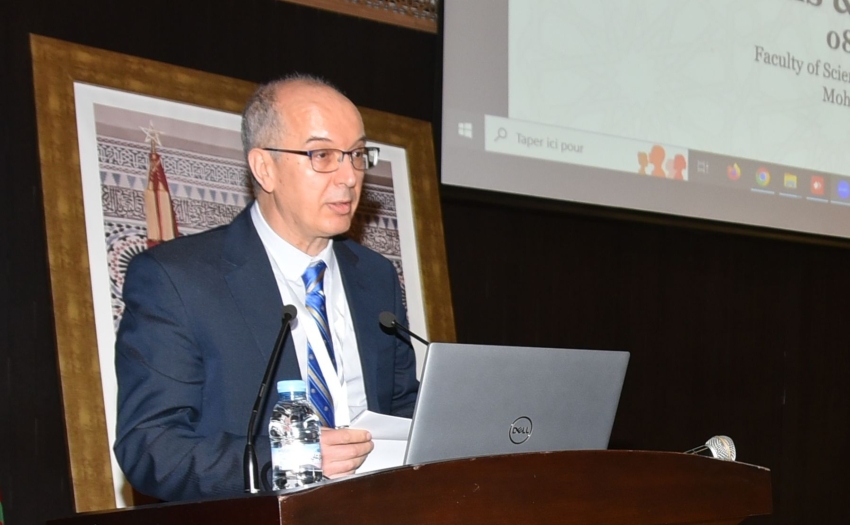News

Interview with Prof. Mohammed Sonebi
Prof. Mohammed Sonebi, Queen's University Belfast, UK, has been RILEM member since 2005. He became Regional Convener for Middle East and North Africa in 2006. Prof. Sonebi was Chair of RILEM TC 266-MRP “Measuring Rheological Properties of Cement-based Materials”. He has also been member of several RILEM Technical Committees (TCs). This interview is to discuss with him the RILEM Tech Lett paper he has recently co-authored, titled Trends and opportunities of using local sustainable building materials in the Middle East and North Africa region.
27 March 2023
***
RIM: I am interviewing today a RILEM superstar: Prof. Mohammed Sonebi, RILEM member since 2005, Chair of TC 266-MRP Measuring Rheological Properties of Cement-based Materials, and DAC regional convener since 2016 for Middle East and North Africa area. This mandate is going to expire soon. Are you sad to leave this role?
Prof. M. Sonebi: That's a good question. Well… I expected it, yes! I took this role of convener of Middle East and North Africa area because of my background (Editor’s note: Prof. Sonebi is originally from Morocco) and also to promote RILEM in this region, especially for those initiatives related to sustainable construction materials.
RIM: When did you meet RILEM?
Prof. Sonebi: RILEM is not something which is new for me. I came across RILEM when I was an undergraduate student and I had my first job at LPEE - Public laboratory for Tests and Studies, more than 30 years ago. At that time, we used RILEM publications for our research, and the LPEE was a very active RILEM member: there had been some technical meetings in Morocco, and the first RILEM recommendation on earth construction (Editor’s note: Hakimi, A., Yamani, N. & Ouissi, H. Results of mechanical strength tests on samples of compressed earth, Mat. Struct. 29, 600–608 (1996)) was produced then, led by my director at that time, Ahmed Hakimi, Chair of TC 164-EBM Mechanics of earth as a building material.
RIM: So, if I understood well, you were not even a PhD student then!
Prof. Sonebi: Correct! I was a MEng graduate from Mohammadia School of Engineering in Morocco (Rabat), same place where we had the recent 2023 RILEM Spring Convention. I wanted to do a PhD but I couldn't find a scholarship, so I started a position at LPEE and I worked there for almost 5 years. As an engineer in charge of control and testing of construction materials and R&D engineer, I read and used many RILEM publications at that time; I was also involved in quality control techniques, like, for instance, for the Hassan II Mosque where, for the first time, high performance concrete with silica fume was used. I spent 2 years following the first experimental house made with gypsum, now a 32-year-old villa, still standing! It was the topic of my plenary keynote at the 2023 RILEM Spring Convention. At the time, we didn't know what the carbon footprint of the gypsum was, as it was before the Kyoto Protocol, which was signed in 1992… the construction of the house finished in 1989! When I moved to finish my MSc and PhD in Canada, in Sherbrooke University, I continued to use RILEM publications. After that, I moved to work in a European project on Rational Production and Improved Working Environment through Using Self-Compacting Concrete” Brite EuRam project. My director at the time, Prof. Peter Bartos, was leading TC 145-WSM “Workability of special concrete mixes”. I worked with him then and I co-authored a book which was published in 2002 (Editor’s note: Workability and Rheology of Fresh Concrete: Compendium of Tests - Report of RILEM TC 145-WSM).
RIM: You worked in the technical committee, but you were not officially a RILEM member.
Prof. Sonebi: Yes, that's true. I was not officially a RILEM member. But it was also in my mind to join as soon as I could. I joined RILEM in 2005 when I moved to Queen's University Belfast.
RIM: In your role as regional convener for Middle East and North Africa, you recently co-authored a paper published in RILEM Tech Lett, titled “Trends and opportunities of using local sustainable building materials in the Middle East and North Africa region” with eight other people.
Prof. Sonebi: Well, first of all, as I said, I would like to thank all my co-authors and their contribution and effort to publish this first paper related to this region. I think it's good timing, by the way, to have this interview, as we just had the 2023 RILEM Spring Convention in Morocco: it was my dream, I would say, to bring for the first time in Africa a RILEM Convention in junction with the CMSS 2023, the fourth series of the Congress on Material and Stability (Editor’s note: the details of this event are available here). I am passionate to promote sustainable construction materials… it's in my blood I would say. When I grew up in Morocco, my grandparents’ house was built with adobe, with no cement at all, just adobe with natural fibres at the time. I am sorry we lost some of this knowledge nowadays, but also glad to see some technical committees on this topic coming back (Editor’s note: BEC : Bio-stabilised earth-based construction: performance-approach for better resilience , MAE : Mechanical performance and durability assessment of earthen elements and structures , and PEM : Processing of earth-based materials ). Climate change now it's something which we cannot neglect. It's climate emergency, I would say… see what happened in the last months with killer hurricanes in Mississippi, fires in France and California, drought in Europe. We are responsible in our daily life, since we wake up in the morning, on how we are affecting climate change and to reduce greenhouse gas emissions, how we can reduce the carbon footprint, etc… In terms of building heating, building materials, we should promote sustainable construction materials especially in this MENA area. So, the paper discusses the use of bio-based materials, earthen material waste, municipal solid waste incineration, waste demolition, and gypsum (producing 7 times lower CO2e compared to cement) of which I gave a good example in this experimental house I presented in my plenary keynote in Rabat; furthermore, we have huge reserve of it in Middle East and North Africa.
RIM: I noticed that 2 of the 9 authors of this paper are from Ukraine.
Prof. Sonebi: Yeah that's correct! When I was looking for colleagues and friends to help me to write this paper, I tried to find colleagues from MENA region with experience in local materials, like for instance Prof. Sofiane for bio-based material, Prof. Elhem for earthen material, Prof. Said for gypsum, Dr Ahmed for demolition waste who really helped me to finalize the paper, etc…
RIM: … and what about Natalia and Leonid?
Prof. Sonebi: I met Natalia in 2016 during a nice workshop in Ukraine, in Rivne, with my colleague Prof. Jamal Khatib, who worked in UK for several years and he moved a couple years ago in Lebanon. Jamal helped us a lot with the paper, contributing in the aspects related to municipal solid waste incineration ashes. After that workshop, I learned there are huge quantities of phosphogypsum in the area of North Africa, especially Morocco; Morocco is the first exporter of phosphates, it produces a lot of fertilizer made from phosphate and we have a lot of phosphogypsum that can be treated to be used in construction. Natalia and Leonid have experience in this topic because also Ukraine has lot of phosphogypsum. So I invited them to contribute and they said “yes!”. If you look at the paper, Natalia and Leonid wrote the good part on statistic of phosphogypsum in different countries of MENA. I was very keen to write this paper, not only because this is my background but also because of my commitment to promote sustainability construction materials. For me, reducing carbon footprint is a priority and our future in our hands.
RIM: Do you think that this paper is just for civil engineers or is there a message there for other type of readers than civil engineers? If you had to promote it in other communities beyond the community of civil engineers, who do you think should read your paper?
Prof. Sonebi: That is good question. Well first of all, it's not only for civil engineers. I would say architects too, because architects love bio-based building materials, they use earth, they use gypsum. As I said, construction is N.1 priority, and governmental bodies and organizations to promote sustainable construction materials with lower carbon foot print should read this paper because it's not too scientific, and because these local materials can be not only in this MENA region, but they can be in other regional cities in South America and Asia and other countries. This is what you have there in Ukrainian, for instance. It's everywhere. Other readers should be researchers, students, government politicians because they can promote sustainable construction materials.
RIM: We have been talking about climate change for maybe 10 years now in a very efficient way. Why some of the materials that you have highlighted in your paper are still in the R&D stage? Why the gypsum house you presented in your recent plenary keynote is still a one-off case?
Prof. Sonebi: That is a difficult question. I think we lost this know-how to use these materials in construction. These houses were made maybe of stone, earth, gypsum, timber, natural fibers, bamboo… but we are losing out now with modern construction. For example, these materials cannot be used for high-rise building, but they are suitable for individual-residential houses, especially now that the price of “normal” concrete is high compared to some locally sourced materials which are cheaper. Gypsum, for instance, is low cost material, very low carbon foot print and reduce cost of construction using technique of slip forming (béton banché)!
RIM: But then you have to convince a builder to do something in gypsum rather than cement.
Prof. Sonebi: Of course, there is a lot of work to be done to train these people. There is more research needed in this area.
RIM: So the research is there but not the development.
Prof. Sonebi: Yeah, development is small. We also need to convince the developers, the government, the councils to go into this direction, to promote these materials.
RIM: When you talked about your chat with Prof. Alexandra Bertron – Editor in Chief of RILEM Tech Lett, I think I heard you mentioning a “first paper” on Middle Eastern North African region. Are you planning to have another one?
Prof. Sonebi: Well, yeah, that's true. I would like to have another one, maybe more focused on earthen materials. We have been limited by the number of pages (it was supposed to have six-eight pages, and we ended up with 12 pages!). I would like to have a second paper on earth, another one only on gypsum for example, and another one on bio-based building materials in this region! Now we can even see that we can build earthen materials with robots: it is one of the conclusions of this paper. In section 5, “Additive manufacture of earth materials” it is explained that robots can save time and you can have better precision, and it's possible!
RIM: Thank you again for making the time for this interview, I know you're very busy. See you maybe soon in Vancouver?
Prof. Sonebi: Definitively!

 5
5












No comment
Log in to post comment. Log in.